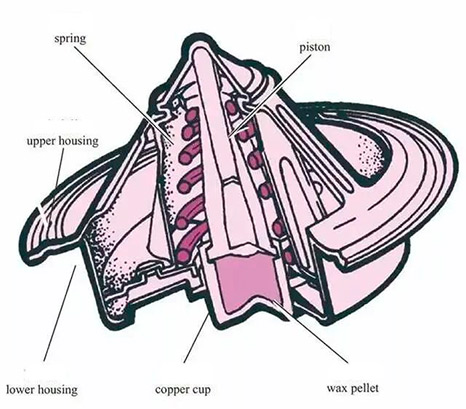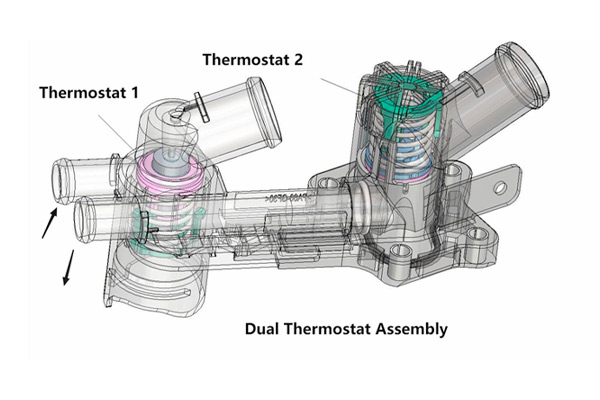
Wax type thermostat is the most widely used in combustion engines, and SDZ possesses and masters matured skills of wax thermostat's development and production. The wax pellet thermostat in the copper expands when it heats up and contracts when it cools.
The wax is enclosed in a metal capsule in touch with water. The valve close when the wax is cooled. It blocks the passage of water into the radiator. When the wax is heated and expands, and the rod is expelled. The valve opens and wax is cooled, and closed by spring.
Wax thermostat is mainly composed of
1. main valve
2. bypass valve
3. inductive element (wax pellet)
The inductive element is the core part of automotive electronic thermostat work
Wax Thermostat has simple structure and low cost thus has a wide application in a conventional vehicles.

Wax Expansion: A wax type thermostat consists of a sealed chamber filled with a wax that expands when heated. As the wax expands, it pushes a piston or a diaphragm, which activates a valve.
Valve Operation: The valve can either allow or restrict the flow of a coolant or a refrigerant, depending on the type of thermostat. For example, in a car engine cooling system, the thermostat valve opens when the engine reaches a certain temperature, allowing coolant to flow through the engine and cool it down.
Temperature Control: Once the wax has expanded and the valve is open, the coolant or refrigerant flows through the system and reduces the temperature. As the temperature drops, the wax contracts, and the valve closes, restricting the flow of coolant or refrigerant. This cycle continues, maintaining the desired temperature.
Wax type thermostats are commonly used in heating and cooling systems, as well as in vehicle engine components. They are reliable, accurate, and durable, making them a popular choice for temperature control applications.
Most Required Products that you May Interest
Electronic Control Unit: Automotive position sensor
Engine Hose 1: EGR coolant hose
Engine Hose 2: Auto coolant hoses
Engine Hose 3: Automotive heater hose
Engine Hose 4: car air conditioning tube
Other Engine Parts: intake manifold for sale
Thermostat 2: Map controlled engine cooling thermostat
Thermostat 3: Cooling system thermostat housing


Only one thermostat on the engine cannot meet the optimal operating temperature requests of different parts of the engine. To solve this situation, SDZ car engine cooling system parts technology support the application of a dual thermostat. It includes two thermostats with different opening temperatures.
The lifespan of a wax-type thermostat in a car's cooling system depends on various factors, including the quality of the component, the operating conditions of the vehicle, and how well the cooling system is maintained.
In general, wax thermostats made by engine parts factory are designed to last for a long time and are considered to be reliable components in a car's cooling system. However, over time, the wax element may lose its ability to expand and contract consistently, leading to problems with regulating the flow of coolant. The thermostat valve may also become clogged with debris or fail due to mechanical issues, causing the engine to overheat or run too cold.
It is recommended to replace the thermostat as part of routine maintenance every 50,000 to 100,000 miles, or if there are signs of malfunctioning such as overheating, poor fuel efficiency, or a dashboard warning light indicating a problem with the cooling system. By replacing the thermostat periodically and keeping the cooling system well-maintained, the lifespan of a wax-type thermostat can be maximized, helping to ensure the optimal performance and longevity of the vehicle's engine.
A wax thermostat, also known as a thermal wax element, is a type of thermostat commonly used in automotive cooling systems. It works by using a wax-filled cylindrical capsule to regulate the flow of coolant in the engine.
The wax in the capsule expands as it is heated, causing the piston to move and open the coolant valve. This allows coolant to flow through the engine and radiator, absorbing heat from the engine and transferring it to the air. As the temperature of the engine drops, the wax in the capsule contracts, causing the piston to move back and close the valve, reducing the flow of coolant.
The expansion and contraction of the wax in response to changes in temperature control the opening and closing of the coolant valve, helping to maintain the engine temperature within the optimal range. The thermostat housing contains the wax capsule and the valve, and it is usually located between the engine and the radiator.
Wax thermostats are reliable and efficient, and they are widely used in modern cars. However, they can become clogged with debris or fail due to mechanical issues, leading to overheating or engine damage. Therefore, it is essential to maintain the cooling system and replace the thermostat when necessary.


If you would like to custom your own car engine parts or request a quote, please fill out the form below with any questions or concerns.


